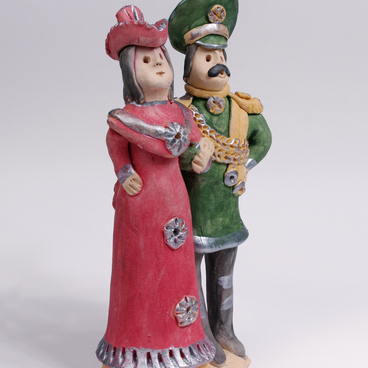The Filimonovo folk handcraft originated with the village of Filimonovo, the Odoev district, the Tula region. Experts have no information about the exact date of its origin, but some historical sources attribute it to the 16th century. Legend has it that the village of Filimonovo was named after an elderly man Filimon — a prisoner who had escaped from his penal colony, a potter, an icon painter, and a toymaker.
By the middle of the 19th century, Filimonovo goods were well known beyond the Odoev district. Traditionally, men made tableware, and women made whistle-toys. Locals called them ‘svistulichnitsas’ (whistles makers). Craftswomen passed the secrets of the craft from one generation to another and maintained this tradition even in the roughest times. During famines or wars fewer toys were produced, but they never disappeared for good.
The clay toys were usually made in late fall. They were dried on Russian masonry stoves or on sleep ledges. The firing took place in February or March; the toys were painted during the Great Lent and were ready for sale at the fair by Easter. Different families had their own secrets of molding and painting, but the main features of the style remained the same for centuries.
Filimonovo toys were made of local clay called ‘sinika’. Flexible and greasy, when dried, it got easily deformed — small cracks appeared in the clay and the craftswomen smoothed them with wet hands. During this process, the figurine was stretched and acquired elegant curved outlines.
After firing, ‘sinika’ toys became evenly white, so there was no need to prime them. Usually, three colors were used for painting the toys: yellow, fuchsia, and green. Sometimes blue and purple shades were used as well. The dyes were often translucent, and, when put in layers on one another, they formed two or three more colors. This is how the figurines became so brightly colored.
Modern Filimonovo craftsmen make toys of the same clay that was used by ancient potters. They fire it in muffle furnaces and use bright acrylic paints to decorate the toys. No matter how complicated the artist’s design is, the traditional toy is always made as a whistle.
By the middle of the 19th century, Filimonovo goods were well known beyond the Odoev district. Traditionally, men made tableware, and women made whistle-toys. Locals called them ‘svistulichnitsas’ (whistles makers). Craftswomen passed the secrets of the craft from one generation to another and maintained this tradition even in the roughest times. During famines or wars fewer toys were produced, but they never disappeared for good.
The clay toys were usually made in late fall. They were dried on Russian masonry stoves or on sleep ledges. The firing took place in February or March; the toys were painted during the Great Lent and were ready for sale at the fair by Easter. Different families had their own secrets of molding and painting, but the main features of the style remained the same for centuries.
Filimonovo toys were made of local clay called ‘sinika’. Flexible and greasy, when dried, it got easily deformed — small cracks appeared in the clay and the craftswomen smoothed them with wet hands. During this process, the figurine was stretched and acquired elegant curved outlines.
After firing, ‘sinika’ toys became evenly white, so there was no need to prime them. Usually, three colors were used for painting the toys: yellow, fuchsia, and green. Sometimes blue and purple shades were used as well. The dyes were often translucent, and, when put in layers on one another, they formed two or three more colors. This is how the figurines became so brightly colored.
Modern Filimonovo craftsmen make toys of the same clay that was used by ancient potters. They fire it in muffle furnaces and use bright acrylic paints to decorate the toys. No matter how complicated the artist’s design is, the traditional toy is always made as a whistle.

